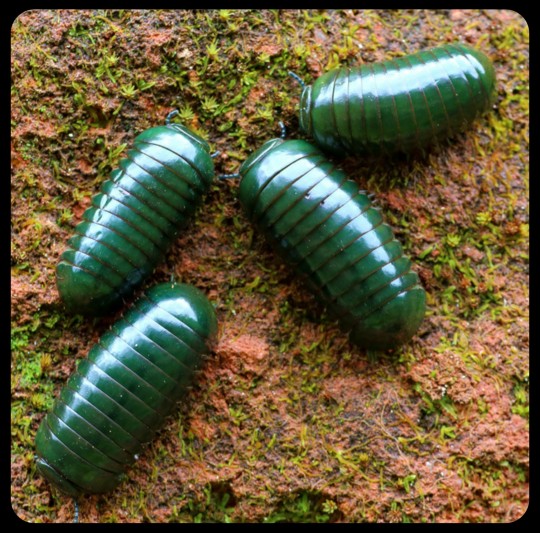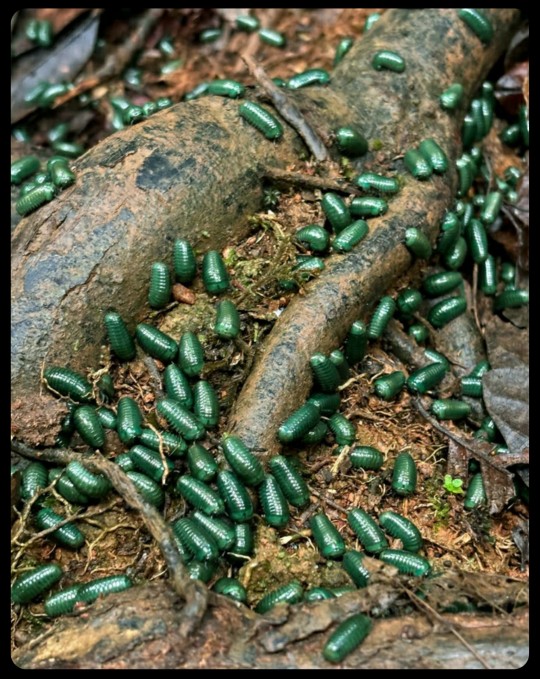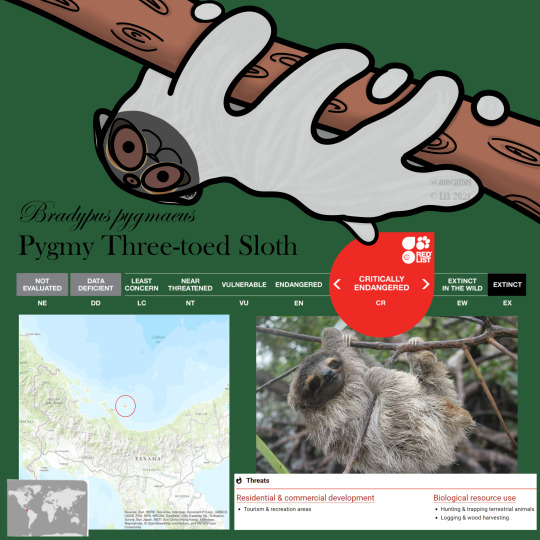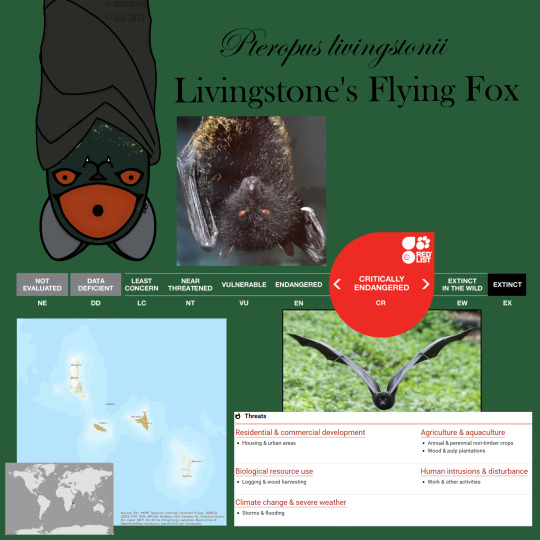#Marojejy
Explore tagged Tumblr posts
Note
your pfp looks like an AI generated image
I'm not sure what to do with that information. Would this one be better?

#selfie#face#my face#that thing on the front of my skull#there has never been a more on-brand photo tbh#gpoyt#gecko#Uroplatus#Uroplatus giganteus#Marojejy#answers by Mark#anon#anonymous#I had to google pfp#older generation tumblrina
2K notes
·
View notes
Text
Giant Emerald Pill-Millipede: when these enormous millipedes are all rolled up, their bodies can be as big as a baseball, a tennis ball, or a small orange

This species (Zoosphaerium neptunus) is commonly known as a giant emerald pill-millipede. The females can measure up to 90mm long (roughly 3.5 inches), making this the largest species of pill-millipede in the world.

There is a significant degree of sexual dimorphism in this species, with the males measuring only about 45mm (1.8 inches) long -- roughly half the size of the females.
Giant emerald pill-millipedes are found only in Madagascar, which is home to several endemic species of giant pill-millipedes (order Sphaerotheriida). The Malagasy name for giant pill-millipedes is "Tainkintana," which means "shooting-star."

Pill-millipedes use conglobation as a defense mechanism, which means that they can curl their bodies up into a spherical shape so that their dorsal plates form a protective shield around the softer, more vulnerable parts of their bodies, just like an actual pill-bug or a "roly-poly."
When they roll themselves up completely, they look almost like gently polished chunks of malachite, emerald, or jade.

Giant emerald pill-millipedes will sometimes form large swarms that travel together as a group. This is the only species of giant pill-millipede that engages in any sort of swarming behavior, and the purpose of that behavior is still unclear. The swarms often contain thousands of individuals, with almost all of them moving in the same direction, even when there is no physical contact that might allow the millipedes to "herd" one another along.

Their swarming behavior also has some very peculiar features, as this article explains:
During swarming, Zoosphaerium neptunus individuals pay little attention to their surroundings; many specimens were observed walking straight into and drowning in small puddles. Some swarms even display ‘cliché lemming behaviour:' in Marojejy, a large part of a swarm walked into and drowned in a small river.
No single specimen was observed walking ‘against the current,' all specimens were moving in the same direction (southeast), even when not in contact with one another.
Of 273 randomly collected individuals, 105 were males, while 168 were females. The males were 8.3 - 14.1 mm wide (average width 10.4 mm). According to the inner horns of the posterior telopods, all males were sexually mature. The females were 9.95 - 15.4 mm wide (average width 11.4 mm). All females displayed non sclerotized vulvae and were sexually immature.
Some researchers argue that the swarming serves as a defense mechanism, providing a layer of protection (or at least some cryptic cover) against local predators, but the swarming behavior is still poorly understood.

Important Note: I just want to remind everyone that these animals belong in their own natural habitat -- they should not be trapped, bought/sold, traded, shipped, collected, or kept as pets. This particular species does not survive well in captivity, either, and the demand for these "exotic" invertebrates is putting the wild populations in jeopardy. The previous article discusses those issues, too:
Another possible threat for Z. neptunus swarms are collections for the pet trade. There exists a large demand in Japan, Europe and North America for 'green -eyed monsters’ as pets. Giant pill -millipedes from Madagascar unfortunately have a very short survival time in terraria. The species is specialized on low-energy food (dead leaves), and adapted to the cool climates (<20°C) of the highlands. Specimens in terraria often starve to death quickly.
So I know that they're adorable and really, really fascinating...but let's just let them be their chunky, adorable little selves out in the wild where they belong.
Sources & More Info:
European Journal of Taxonomy: Seven New Giant Pill-Millipede Species and New Records of the Genus Zoosphaerium from Madagascar
Madagascar Conservation & Development: Swarming Behavior in the World's Largest Giant Pill-Millipede, Z. neptunus, and its Implication for Conservation Efforts
Bonn Zoological Bulletin Supplementum: The Giant Millipedes, Order Sphaerotheriida (an Annotated Species Catalogue) (PDF)
African Invertebrates: Madagascar's Living Giants: Discovery of Five New Species of Endemic Giant Pill-Millipedes from Madagascar (PDF)
#arthropods#giant green pill-millipede#zoosphaerium neptunus#myriapods#diplopoda#millipedes#island gigantism#entomology#evolution#malagasy#cool animals#bugs#insects#animal facts#madagascar#pill-millipede#pill bugs#but not really#Tainkintana#conglobation#swarming#conservation#giant emerald pill-millipede
6K notes
·
View notes
Text



Giant Leaf-tailed Gecko (Uroplatus giganteus), family Gekkonidae, Marojejy National Park, Madagascar
photograph by Patrick Madagascar Tour Guide
450 notes
·
View notes
Photo



Le microcosme malgache depuis la Suède (thanks to IPSIO.org)
#scientific illustration#madagascar#marojejy#insects#comet moth#net casting spider#crickets#illustrator#ai
232 notes
·
View notes
Video
youtube
While at the Marojejy National Park in Madagascar, wildlife photographer David Weiller (previously) captured mesmerizing footage of a giant fire millipede crawling up a branch with its 160 red legs moving in stunning locomotion. (...)
Via: Laughing Squid.

1 note
·
View note
Photo

Ring-tailed Mongoose (Galidia elegans) Marojejy National Park, Madagascar
The ring-tailed mongoose is not a true mongoose, but instead belongs to the closely related family of endemic Madagascan carnivores, Eupleridae.
Photograph © Chien Lee
258 notes
·
View notes
Photo





(c) LIA 2021
Week 2: Floral
“Wild Hearts Challenge 2021″
6 endangered species from forest habitats, including 3 mammals, 2 plants and 1 fungus:
Pygmy Three-Toed Sloth (Isla Escudo de Veraguas, Bocas del Toro Islands, Panama)
Livingstone’s Flying Fox (Anjouan and Mohéli, Union of the Comoros)
Flat-Headed Cat (Sumatra, Borneo and the Malayan Peninsula)
Dypsis cookei (Marojejy mountain, northern Madagascar)
Tiny Flowered Paphiopedilum (northern Viet Nam & southern China)
Barbie Pagoda (New Caledonia)
All are either critically endangered or endangered.
Buy on Redbubble!
For more information, see:
Sewall, B.J., Young, R., Trewhella, W.J., Rodríguez-Clark, K.M. & Granek, E.F. 2016. Pteropus livingstonii. The IUCN Red List of Threatened Species 2016: e.T18732A22081502. https://dx.doi.org/10.2305/IUCN.UK.2016-2.RLTS.T18732A22081502.en. Downloaded on 24 January 2021.
Wilting, A., Brodie, J., Cheyne, S., Hearn, A., Lynam, A., Mathai, J., McCarthy, J., Meijaard, E., Mohamed, A., Ross, J., Sunarto, S. & Traeholt, C. 2015. Prionailurus planiceps. The IUCN Red List of Threatened Species 2015: e.T18148A50662095. https://dx.doi.org/10.2305/IUCN.UK.2015-2.RLTS.T18148A50662095.en. Downloaded on 24 January 2021.
Voirin, B., Smith, D., Chiarello, A. & Moraes-Barros, N. 2014. Bradypus pygmaeus. The IUCN Red List of Threatened Species 2014: e.T61925A47444229. https://dx.doi.org/10.2305/IUCN.UK.2014-1.RLTS.T61925A47444229.en. Downloaded on 24 January 2021.
Rakotoarinivo, M. & Dransfield, J. 2012. Dypsis cookei. The IUCN Red List of Threatened Species 2012: e.T195980A2438774. https://dx.doi.org/10.2305/IUCN.UK.2012.RLTS.T195980A2438774.en. Downloaded on 24 January 2021.
Rankou, H. & Averyanov, L. 2015. Paphiopedilum micranthum. The IUCN Red List of Threatened Species 2015: e.T191772A2002560. https://dx.doi.org/10.2305/IUCN.UK.2015-2.RLTS.T191772A2002560.en. Downloaded on 24 January 2021.
Leonard, P.L. 2019. Podoserpula miranda. The IUCN Red List of Threatened Species 2019: e.T154605211A154605228. https://dx.doi.org/10.2305/IUCN.UK.2019-3.RLTS.T154605211A154605228.en. Downloaded on 24 January 2021.
#cat#catto#alien#monster#alien monster#alien monster cattos#digital art#Digital Illustration#Illustration#wildhearts2021#wild hearts 2021#wildlife conservation#wildlife#wildlife art#IUCN#redlist#iucnredlist#endangered#endangered species#critically endangered#flat-headed cat#livingstone's flying fox#pygmy three-toed sloth#flying fox#wildcat#sloth#forest#barbie pagoda#orchid#fungus
7 notes
·
View notes
Photo


Lined Leaf-tailed Gecko by Frank Vassen Marojejy National Park, Madagascar
196 notes
·
View notes
Photo

robertolerche
Let's get out of our comfort zone, drop our defensive walls and dive into the infinite depths of the unknown. Vulnerable but courageous, eager to be taught new things about ourselves and the world around us.. it's a safe way to find true meaning in life.
And we don't even have to travel the world to do so.. sitting in a silent room with our eyes closed is enough to launch the most profound of all journeys.. 🧘🏻♂️
...
Marojejy National Park, Sambava, Madagascar
...
#tuffo#immenso#skinnydip#dive
#meaning#rainforest#jungle
#marojejy#sambava#madagascar
#openmyworld#wanderlust#sony7aii#samyang35mm
27 notes
·
View notes
Note
how the hell do you find so many frogs

This is a photo I took of Miguel Vences, one of my two doctoral supervisors, and I believe the most prolific living frog taxonomist, demonstrating how one finds so many frogs: looking carefully in the right place, and knowing what one is looking for/at. Here, we were at the top of Marojejy, a mountain in northeastern Madagascar. On this trip we discovered several new frog and lizard species.
You can also watch a film where I talk a bit about some of the work that goes into discovery, from my trip to the Bealanana district in northern Madagascar.
vimeo
This expedition yielded MANY new species.
#discovery#taxonomy#new species#frogs#nature#Madagascar#answers by Mark#yurimartyr#Sméagol was onto something when he got interested in the roots of things and happenings under stones#just took it maybe a smidge far
486 notes
·
View notes
Note
Hi!! I recently saw a post about leaf tailed geckos (so shaped) and I was wondering if you had any cool facts about them?
Leaf-tailed Geckos:
Leaf tailed geckos, genus Uroplatus, have a pretty tough (ossified) skull and a high tooth count for their size. The largest species, U. giganteus can grow total length of about a foot! They are all highly cryptic, blending in with tree bark and dead leaves. Like most geckos, they are nocturnal and insectivorous.


Satanic Leaf-tailed Gecko (Uroplatus phantasticus), family Gekkonidae, central Madagascar
photographs by Reptiles4all & Thorsten Negro

Leaf-tailed Gecko (Uroplatus garamaso), family Gekkonidae, endemic to northern Madagascar
* This species used to be considered a population of Henkel’s Leaf-tailed Gecko, U. henkeli. They were recognized as a distinct lineage for awhile, but were only elevated to species status this year, 2023.
Photograph by Thorsten Negro


Corkbark Leaf-tailed Gecko (Uroplatus pietschmanni), family Gekkonidae, endemic to a small area of eastern Madagascar
ENDANGERED.
photographs by Reptiles4all & Crestie Jungle


Giant Leaf-tailed Gecko (Uroplatus giganteus), family Gekkonidae, Marojejy National Park, Madagascar
photograph by Patrick Madagascar Tour Guide
262 notes
·
View notes
Photo

Partir à Stockholm pour travailler sur un poster sur les insectes d’un parc national à Madagascar... done.
87 notes
·
View notes
Text
Madagaszkár meglepetései

Madagaszkár egy fantasztikus szigetország az Indiai-óceánon, mely az afrikai kontinens dél-keleti lábánál található. Madagaszkár szigete a világ negyedik legnagyobb szigete, de még további kisebb szigetek is tartoznak hozzá. A sziget miután elvált a kontinenstől, az állati és növényvilág sajátos fejlődésnek indult, a teljes elszigeteltség endemizmusokat hozott létre egyedi fajok kialakulásával. Az itt élő fajok 90 százaléka sehol máshol nem található meg a Földön. Ritka állatai között 70 fajta gyűrűs farkú maki, más néven katta vagy lemúr, és a világ legkisebb és legnagyobb kaméleonja is megtalálható, páratlan növényeit többek között 930 orchidea faj gazdagítja. Az ország kultúrájában jelentős szerepet töltenek be a bevándorló arabok és kelet-afrikaiak,malájok, indiaiak, franciák, de az őshonos népnek a malgasok számítanak. A XIX. században az ország szuverenitása megszűnt a francia egyesítéssel, és csak 1960 júniusában történt meg a független állam kikiáltása, a fővárosa pedig Antananarivo. A XVII. században épült és 2001 óta a Világörökség részét képező Ambohimanga palotát is meglátogathatjuk itt, és a palota mellett található kilátóhelyről megcsodálhatjuk a város panorámáját. A lakosság közel 25 millió fő. Madagaszkár tengerszint feletti magassága 750 és 1350 méter között van, de több magasabb hegység is van, a legmagasabb csúcs pedig a 2876 méter magas Maremokotro. A fő sziget magasföldi jellegű kopár tájain a dombok közötti völgyekben teraszos rizstermesztést folytatnak, melyeket a széles medrű folyók vízhozama is támogat, del ta torkolatuk pedig remek kikötőknek ad helyet. 2007-ben Atsinanana esőerdői névek 6 nemzeti parkot nyilvánítottak világörökséggé, a következőeket: a Marojejy, Masoala, Ranomafana, Zahamena, Andohahela, Andringitra nemzeti parkok. Madagaszkár a Föld egyik legszegényebb állama, mely ásványkincsekben (grafit, vasérc, csillámpala, féldrágakövek, urán, króm, titán) gazdag. Az ország lakosságának nagy része a rizs, és manióka termesztéséből, halászatból és fakitermelésből él. Exportra borsot, szegfűszeget, vaníliát, kávét, dohányt, és cukornádat termesztenek. Változatos tájak jellemzik: keleten buja, zöld trópusi őserdőkkel borított hegyek, a sziget közepén teraszos rizsföldek, nyugaton sziklás és füves síkságok, majomkenyérfák teszik változatossá vidéket, a part mentén pedig fehér homokos partszakaszok találhatóak. Antsirabe az ország harmadik legnagyobb városa, a sós vizű termálfürdők városa, az ország söripari központja, rengeteg riksát találunk itt. Francia koloniális stílusban épült házak jellemzik, csodálatos katedrális és a helyi kézművesek színes kavalkádra emlékeztető választéka a domináns. Ambositra városa a madagaszkári fafaragás központja, értékes rózsafából és ébenfából készült kézművesipari termékek gazdag kínálatát fedezhetjük itt fel. A Ranomafana Nemzeti Park az ország második legnépszerűbb nemzeti parkja, mely számos őshonos, endemikus állat-és növényfajt rejt magában. Dús, buja esőerdője rendkívüli vegetációval rendelkezik: pálmák, orchideák, bambuszok, páfrányok mellett az erdő számos lemúrfaj kedvelt tartózkodási helye, így a bambusz-lemúr, a vörös maki és a törpe egérmaki is társunkul szegődhet. Az Andringitra Nemzeti Park Madagaszkáron, mely több, mint 100 különböző madárfajt, 50 emlősfélét és 55 békafajtát rejt. Növényfajokból is több, mint 1000 faj él a parkban. Az Isalo Nemzeti parkban a tájat hatalmas homokkő sziklák uralják, és kanyonok, a sziklák tetején vezető szűk, de lélegzetállító panorámát nyújtó ösvények, hegyi források, egyedülálló növényzet, és állatvilág teszi felejthetetlenné. Madagaszkáron két évszak jellemző: a november-március közötti forró és esős évszak és az április-október közötti enyhébb, szárazabb évszak. Az átlaghőmérsékletek és a csapadék mennyisége nagyon eltér az ország különböző régióiban. Vannak egész évben látogatható területek, mint a dél-nyugati országrész, de a keleti partvidéket csak május és október között érdemes felkeresni az olykor ciklonokat is hozó esős évszak elkerülése miatt. A madagaszkári iparművészet egyben kézművességet is jelent, csakis kézzel készített, ízléses, időigényes és minőségi termékeket készítenek. Madagaszkáron a turisztikai és közúti infrastruktúra még nagyon fejletlen és emiatt sok kényelmetlenségre számíthatunk, de a látvány mindent megér. Read the full article
0 notes
Text
Yet another small brown frog from high altitude on the Marojejy Massif, northeastern Madagascar (Anura: Mantellidae).
#pubmed http://dlvr.it/Q6fl93
0 notes
Photo

Silky Sifaka Lemurs, Marojejy National Park, Madagascar – Photo by Kevin Schafer – @schaferpho @natgeo // There have been few moments in my career more satisfying than when my subjects have completely ignored me. Such was the case here, when a small group of sifakas descended from the canopy and decided to have an impromptu, entirely playful, wrestling match on the forest floor just a few yards away from me. So often in nature, animals are terrified by our presence – and generally with good reason – so being simply ignored is a rare privilege. Even more so when the animals are as rare as these Silky Sifakas, counted among the 10 most endangered primates on earth, restricted to a few remote mountaintops in Madagascar. For half an hour, they tangled on the ground, utterly ignoring me and my camera. Eventually they grew tired of the game and rejoined their troop in the trees. As for me, I felt I had been granted something very special, the chance to witness a rare behavior, and to be, if just for a short time, utterly invisible. #marojejy #simpona #silkysifaka #endangeredprimates #endangeredspecies #criticallyendangered #primates http://ift.tt/2j0OAMS
0 notes
Text
To feed a growing population, farms chew away at Madagascar’s forests
http://bit.ly/2jdJUCF SAVA REGION, Madagascar – Squatting barefoot in a field of mud on the outskirts of Marojejy National Park, easing rice seedlings from the earth, Paul Tiozen shrugged out one of Madagascar’s most pressing conundrums: how to get more rice? He looked bitter. “Rice is the source of Malagasy life. It’s so difficult to work the rice, because we need the shovel, and water to work it. I need more land. I have a big family, so I need more. What I want is half a hectare,” he said. Therein lies the catch. Madagascar’s population is about to boom. The International Futures center at the University of Denver estimates that by 2060 Madagascar will have close to 60 million people, up from 25.5 million today. And yet, only 1.2 million hectares of land are used for rice cultivation, a tiny proportion of the island’s total size. To feed its people, agricultural productivity must rise. Rice farmer Paul Tiozen says he needs half a hectare of land to grow enough rice for his family, more farmland than he currently has. Photo by Dan Ashby and Lucy Taylor for Mongabay. But population growth in this largely rural and agrarian country is giving birth to a piece-by-piece land grab of plots, often in the worst possible way for the environment. In the hilly tracks off the mountain road to the town of Andapa in the country’s northeastern Sava region, one can see the plot problem written onto the sides of hills and around the…
0 notes